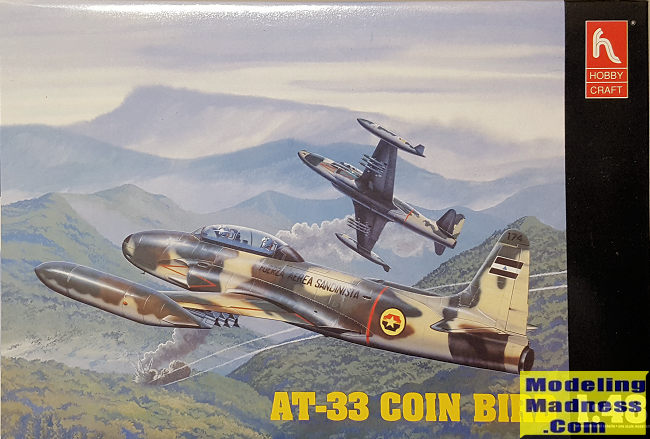
| KIT #: | HC 1547 |
| PRICE: | $ |
| DECALS: | Five options |
| REVIEWER: | Scott Van Aken |
| NOTES: |

| HISTORY |
The T-33 was America's first jet trainer. Based on the F-80 Shooting Star, the fuselage was lengthened to provide room for the second seat and in the process, it made the aircraft faster than the standard fighter. The aircraft was also produced under license in Canada by Canadair and in Japan by Kawasaki.
The type served military services for decades with the last military operated aircraft being retired by the Bolivian Air Force in 2017. Thanks to its simple construction and ease of maintenance, a fair number of airframes are still being flown by civilian pilots. The airframe was also modified for use as a tactical reconnaissance platform and armed T-33s (known as AT-33s) were operated by many smaller air arms in the light attack role.
| THE KIT |
The first 1/48 T-33 was produced by Hawk in 1958. It wasn't a bad kit, but was not very well detailed and typical of kits of the time. Move forward to 1992 and this kit was released by Hobbycraft. It went through a number of boxings before Hobbycraft went out of business and the molds reverted to Academy, who produces the kit.
The kit itself is nicely molded with an acceptable cockpit that has a pair of seats, control sticks, instrument panels and rudder pedals. Before closing the fuselage halves, one installs the nose gear door well, exhaust, and intake blanking plates as well as 1/4 ounce of nose weight and the cockpit assembly. Also added prior to fuselage closure are the gun barrels for the nose.
If doing one of the kit markings options, the holes for the
rockets have to be opened up in the lower wing. Note that on the weapons sprue
are pylons and bombs, but those are not show n
as needed for this kit, though they would not be out of place if used instead of
the rockets. Then the gear well center section and upper wings are attached. The
wings are then attached to the fuselage along with the tailplanes and the clear
bits. You can pose the canopy open if you so desire. One then builds and
attaches the tip tanks, separate flaps, landing gear and doors, along with the
rockets.
n
as needed for this kit, though they would not be out of place if used instead of
the rockets. Then the gear well center section and upper wings are attached. The
wings are then attached to the fuselage along with the tailplanes and the clear
bits. You can pose the canopy open if you so desire. One then builds and
attaches the tip tanks, separate flaps, landing gear and doors, along with the
rockets.
Instructions are well drawn but totally devoid of any color information for the cockpit, seats, gear wells and so on. There are five markings options. One is the box art plane from the Sandinista Air Force. There are two Ecuadoran planes; one in unpainted metal with a large fin flag. The other is in SEA colors with a large sharkmouth. Also in camouflage with a black underside is a Korean option and finally an Uruguayan plane, also in camouflage. For each of the camouflaged planes the colors needed are provided. This is a 'black box' Hobbycraft kit so the decals should be excellent, unlike those from the earlier white boxes which often did not stick at all.
| CONCLUSIONS |
Today, the kit to get is really the GWH version. It has a lot more detail along with more parts and a much higher price tag. Still the Hobbycraft or Academy kits build into nice models and are perfect for those who want something that is fairly quick to build.
March 2021
Copyright ModelingMadness.com. All rights reserved.
If you would like your product reviewed fairly and fairly quickly, please contact the editor or see other details in the Note to Contributors.
Back to the Main Page Back to the Review Index Page Back to the Previews Index Page